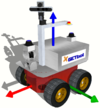Main Page
|
Welcome to Robotics
|
||||||||||||||||||||
|
Important topics
|
MATLAB
Tip of the week
Did you know... ?... that you can determine the inverse of a matrix with the Gauß-Jordan-Algorithm? more
HintThe Robotics Wiki is extended continuously. For that reason some articles are provided with the hint, that they are still under development. Please consider that these articles are possibly incomplete and might contain errors.
Other
|
|||||||||||||||||||








